Did you know that over 1 million birds are killed by outdoor cats each year in the United States? This staggering statistic highlights the significant threat that predators pose to our feathered friends, and it may be one of the key reasons why birds are avoiding your backyard bird feeder. From raccoons and squirrels to larger birds of prey, the presence of these predators can make birds wary of venturing too close to your feeder, leaving you wondering why your avian visitors have vanished.
If you’ve been diligently filling your bird feeder, only to be met with a deafening silence, there’s no need to despair. There are several potential reasons why birds may not be flocking to your feeder, and with a little investigation and some simple adjustments, you can create a welcoming environment that will have birds of all feathers eagerly awaiting their turn at your backyard buffet.
Key Takeaways:
- Predators like cats, raccoons, and larger birds can deter birds from visiting your feeder.
- Ensuring a consistent supply of fresh, high-quality bird seed is crucial to attracting feathered visitors.
- Noise and disturbances near the feeder can scare birds away, so placement and location are important.
- Birds may prefer natural food sources, especially during warmer months when natural abundance is high.
- Regular cleaning and maintenance of your bird feeder helps prevent disease and keep it inviting for birds.
Reasons Why Birds Aren’t Visiting Your Feeder
Attracting birds to your feeder can be a delightful experience, but sometimes, you might find that the feathered friends you’ve grown accustomed to have stopped visiting. Understanding the potential reasons behind this can help you address the issue and get your bird buffet back in business.
Predators in the Area
One of the primary reasons birds may avoid your feeder is the presence of predators nearby. Raccoons, squirrels, chipmunks, and even larger birds can pose a threat to the smaller, more vulnerable species you’re trying to attract. Cats wandering nearby or pets looking out a nearby window can also be enough to deter birds from visiting. To make your feeder a safe haven, consider placing it at least 5 feet off the ground and 10-12 feet away from potential hiding spots like trees or shrubs, giving birds a clear escape route.
Lack of Fresh or Appropriate Seed
If your feeder is full, but the birds aren’t coming, it’s essential to check the condition of the bird seed. Heavy rain can cause the seed to become soggy and moldy, making it unappealing and potentially unsafe for birds to consume. Additionally, using cheaper seed varieties like red or white milo may not attract the songbirds you’re hoping to see. Regularly replenishing your feeder with fresh, high-quality seed can make all the difference in drawing birds back to your yard.
“The types of food offered can influence bird visitation rates; cheaper seed varieties like red or white milo may not attract many songbirds.”
By addressing these common issues, you can create a welcoming environment that will have your feathered friends flocking back to your backyard oasis.
Addressing Noise and Disturbance Issues
If your yard borders a busy street with constant noise or your bird feeder is situated near areas of high activity, it could explain why fewer birds are visiting. Loud noises, whether from traffic, children playing, or boisterous adults, can scare away birds and keep them from approaching your feeder. To create a more inviting environment for our feathered friends, it’s essential to place your bird feeder in the quietest part of your yard, away from streets, play areas, or any other sources of disturbance.
There are a few simple steps you can take to deter noise and minimize disturbances near your bird feeders:
- Position the feeder in a secluded, sheltered spot, such as near shrubs or trees, to provide a sense of safety and seclusion for visiting birds.
- Avoid placing the feeder directly next to a busy road or high-traffic area, as the constant noise and movement can be a major deterrent.
- Consider setting up the feeder in a more private area of your yard, away from areas where children play or adults gather, to reduce the impact of loud noises and activity.
By creating a peaceful, disturbance-free environment around your bird feeder, you’ll increase the chances of attracting a variety of birds to your backyard oasis.
“The sounds of nature – the chirping of birds, the rustling of leaves – can have a calming, restorative effect on the human psyche. By minimizing noise and disturbances, we create a more inviting habitat for our feathered friends to thrive.”
Remember, the placement of your bird feeder is crucial in deterring noise and avoiding disturbances that can drive birds away. With a little consideration and strategic positioning, you can transform your backyard into a haven for the local avian population.
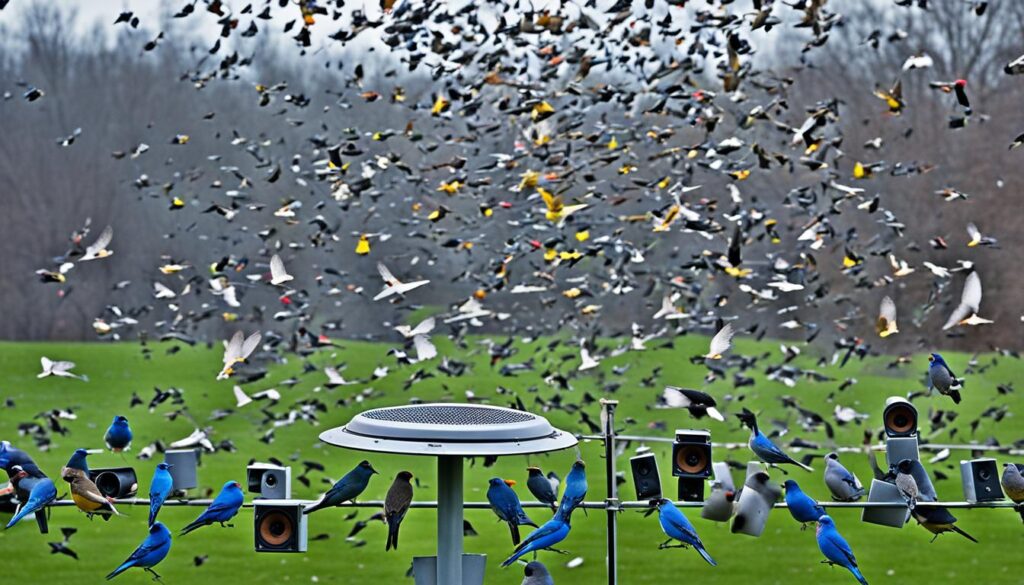
Considering Natural Food Sources and Seasons
As the seasons change, you may notice a decline in the number of birds visiting your feeder. This is not necessarily a cause for concern, as birds have a natural preference for their own natural food sources. During the warmer months, birds can often find an abundance of natural food sources such as insects, seeds, and fruits, making your feeder less of a necessity.
The availability of natural food sources can vary greatly depending on the season and local conditions. For example, in a mast year where trees produce a large amount of fruit or seeds, birds may be less inclined to visit your feeder. Conversely, during leaner seasons, your feeder can become a more attractive option for birds seeking supplemental food sources.
Providing Alternative Food Options
To keep your feathered friends interested, consider supplementing natural food sources by offering a variety of bird seed types or even seasonal treats like suet or nyjer seed. You can also attract birds by adding a bird bath near your feeder, as they often appreciate a reliable source of fresh water, especially during the warmer months.
By understanding the seasonal changes in bird feeding patterns and providing alternative food sources, you can help ensure that your backyard remains a welcoming and abundant haven for your avian visitors throughout the year.
“Providing a variety of food sources and water can help ensure that your backyard remains a haven for birds year-round.”
Ensuring Proper Feeder Placement and Height
Positioning your bird feeder in the right spot is key to attracting feathered friends. The ideal bird feeder placement should be at least 5 feet off the ground, attached to a structure that’s difficult for predators to climb. This helps prevent bird feeder access for predators and gives your backyard birds a safe feeding area.
Furthermore, it’s recommended to place the feeder 10-12 feet away from any potential hiding spots like trees or shrubs. This height of bird feeders and distance from cover allows birds to have a clear view of their surroundings and a quick escape route if necessary.
- Elevate the feeder at least 5 feet off the ground.
- Attach the feeder to a post, pole, or other structure that’s challenging for predators to climb.
- Position the feeder 10-12 feet away from trees, bushes, or other hiding spots.
By carefully considering the ideal bird feeder placement, height of bird feeders, and preventing bird feeder access for predators, you can create a welcoming and safe environment for your backyard birds to enjoy their meals.
“The key to attracting birds is to make them feel safe and secure at your feeder.”
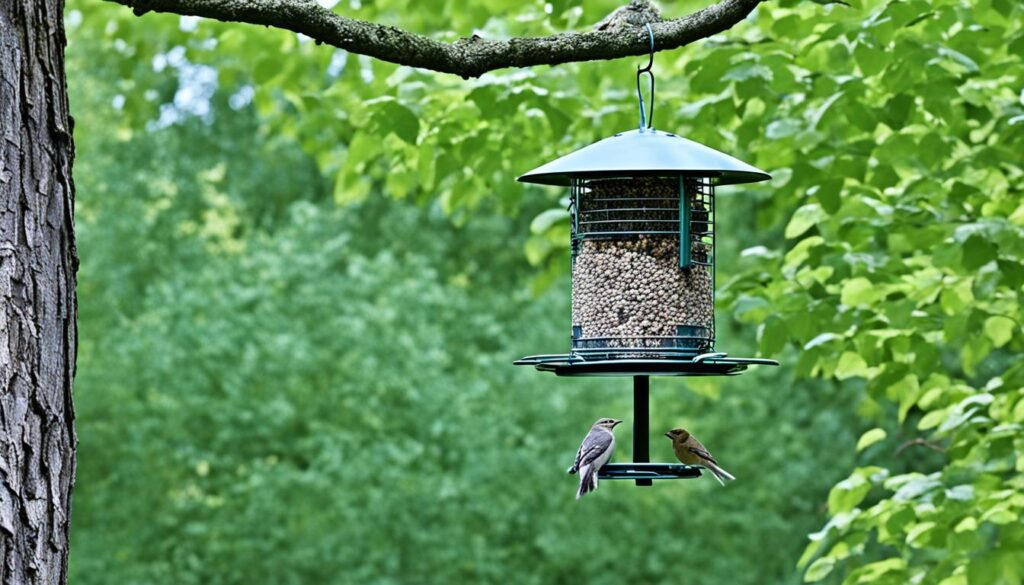
Maintaining Feeder Cleanliness and Hygiene
Keeping your bird feeder clean and hygienic is crucial for attracting and nourishing our feathered friends. Birds won’t visit a feeder with contaminated food, as their instincts warn them of potential health risks. To ensure your bird feeder remains an inviting and safe dining spot, regular cleaning and disinfecting is essential.
Regular Cleaning and Disinfecting
Start by choosing a bird feeder that is easy to clean, with minimal nooks and crannies where bacteria and mold can thrive. Use a bird feeder disinfectant or a specialized hygiene kit to thoroughly clean and sanitize your feeder. Soak the feeder before scrubbing to loosen any dried-on dirt or debris, and be sure to reach into all the corners with a scraper tool.
Wear rubber gloves to avoid contamination, and carefully dry every part of the feeder to eliminate any leftover moisture. Moisture can quickly lead to the growth of mold and mildew, which can make the bird seed unfit for consumption.
- Inspect the feeder for signs of mold, insects, or discolored seed
- Discard any clumped or sprouting seed, as it indicates moisture and potential contamination
- Use a bird feeder disinfectant to kill any bacteria or microorganisms
- Thoroughly scrub and dry the feeder to prevent the growth of mold and bacteria
By maintaining the cleanliness and hygiene of your bird feeder, you can ensure that your feathered friends enjoy a safe and nourishing dining experience, encouraging them to return to your backyard oasis time and time again.
Allowing Time for Birds to Discover New Feeders
Introducing a new bird feeder to your yard can be an exciting prospect for avid bird watchers. However, it’s important to understand that birds don’t always immediately flock to a fresh feeding station. In fact, it can take some time for them to discover and acclimate to a new bird feeder.
According to research, it can take up to a week for birds to notice and start regularly visiting a newly installed feeder. Certain species, like ravens, may take even longer, potentially a few weeks, before they make the feeder part of their feeding routine. Additionally, some birds, like chickadees, may not linger at the feeder for extended periods, instead making quick visits to grab a quick bite.
Once birds do discover the new bird feeders, you’ll likely see a steady stream of winged visitors. To help speed up the process, try scattering a few bird seeds around the feeder area to entice curious birds to investigate. You can also consider placing a shallow pan of water near the feeder, as this can attract birds passing by and increase the chances of them finding your new food source.
“Patience is key when introducing a new bird feeder to your yard. It may take some time, but with a little effort, you can help birds acclimate to the new feeders and make them a regular part of your backyard ecosystem.”
If you find that no birds are visiting your new feeder after a couple of weeks, it may be time to consider adjusting the location or trying a different type of feeder or bird food. Providing a variety of feeding options and being mindful of the natural food sources available to birds in your area can also help attract a wider range of feathered friends to your backyard oasis.
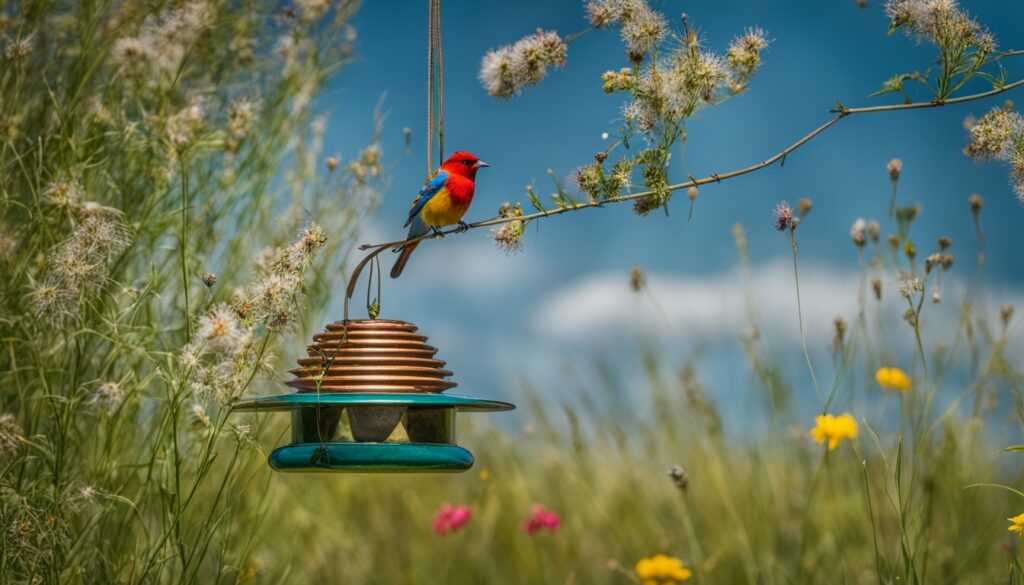
Choosing the Right Seed Types and Quality
When it comes to attracting and nourishing your feathered visitors, the type and quality of bird seed you provide can make all the difference. Beware of cheap bird food mixes that contain filler ingredients like split peas or crushed dog biscuits – the birds simply won’t touch them. Instead, invest in high-quality types of bird seed that are specifically designed to meet the nutritional needs of your local avian population.
Avoiding Filler Seeds and Low-Quality Blends
Some bird food suppliers may try to cut costs by using inexpensive filler materials in their seed mixes. However, these low-quality bird seed blends can actually deter birds from visiting your feeder. Birds have a keen sense of what’s good for them and will instinctively avoid anything that could potentially make them sick.
Remember: Birds won’t eat food that has gone bad, and who can blame them? They know that spoiled or low-quality seed could be detrimental to their health.
To ensure your feathered friends keep coming back, choose high-quality bird seed that is free of filler ingredients and designed to meet the nutritional needs of birds. This investment will pay off in the long run by attracting a wider variety of species and keeping your local birds healthy and happy.
“Investing in the right types of bird seed is crucial for ensuring the health and happiness of your feathered visitors.”
By understanding the importance of high-quality bird seed and avoiding cheap bird seed filled with filler, you can create a thriving bird-friendly environment in your backyard or community. Remember, the birds will appreciate your efforts and reward you with their vibrant presence and engaging behaviors.
Checking for Obstructions or Defects in Feeders
If birds aren’t visiting your feeder, it’s important to inspect it for any potential obstructions or defects that could be keeping them away. Clogged bird feeders and broken bird feeders can be a common issue, but regular maintenance of bird feeders can help ensure your feathered friends have easy access to the nutritious seeds you provide.
One common problem is when the seed overflow area or dispensing mechanism becomes blocked with leaves, pebbles, or even old, clumped-up food. This can prevent the fresh seed from reaching the feeding tray, making it difficult for birds to access the food. When refilling your feeder, take a moment to ensure the seed is flowing freely and that there are no obstructions in the feeder’s various compartments.
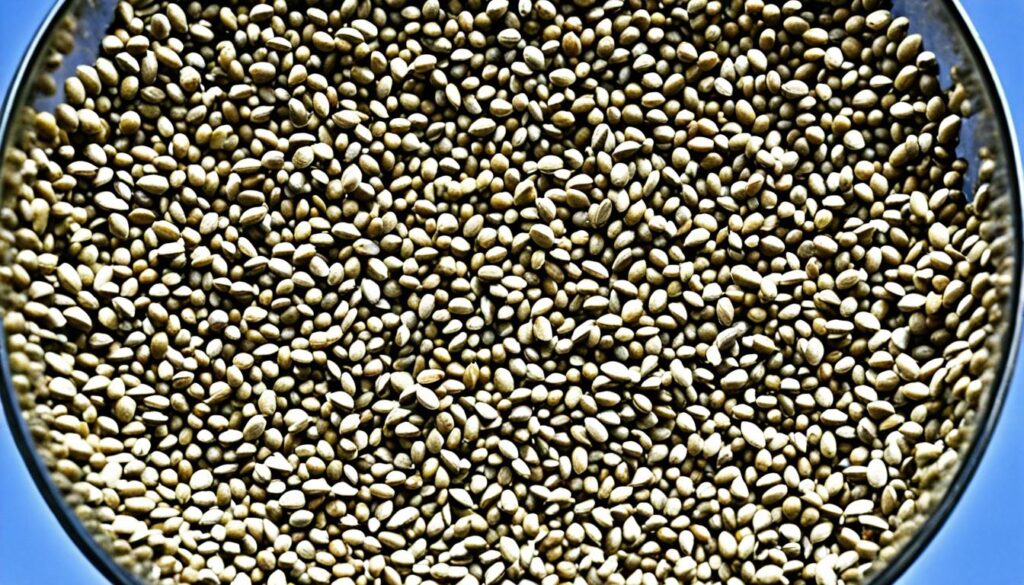
Another issue could be damage or wear and tear on the feeder itself. Over time, the container, perches, or other components can become worn, cracked, or even break, creating barriers that keep birds from reaching the seed. Carefully inspect your feeder for any signs of damage and consider replacing it if necessary to provide a safe and accessible feeding station for your backyard birds.
By staying vigilant and addressing any obstructions or defects in your bird feeder, you can help ensure a steady stream of feathered visitors to your outdoor oasis, allowing you to enjoy their beautiful plumage and lively antics.
why aren’t birds coming to my bird feeder
If you’ve noticed a lack of bird activity at your feeder, you’re not alone. Many bird enthusiasts face this common issue. The reasons why birds may avoid your bird feeder can vary, but understanding the most common causes can help you address the problem and attract more feathered friends.
One of the primary reasons birds may steer clear of your feeder is the presence of predators in the area. Cats, hawks, and other predators can instill a sense of danger, causing birds to be cautious about visiting your feeder. Ensuring your feeder is placed in a secure location, away from potential threats, can help mitigate this issue.
Another factor that can deter birds is the lack of fresh or appropriate seed. Birds have specific dietary preferences, and using the wrong type of seed or allowing the seed to go stale can make your feeder less appealing. Regularly replenishing your feeder with high-quality, bird-friendly seed can make a significant difference.
Noise and disturbances in the area can also play a role in why birds avoid your feeder. If your feeder is located near a busy road, construction site, or other sources of constant noise, birds may feel uneasy and choose to feed elsewhere.
Seasonality and natural food sources can also impact bird activity at your feeder. During spring and summer, birds may be more focused on finding insects and natural foods to feed their young. In fall and winter, however, they tend to visit feeders more frequently as they seek high-energy foods to fuel their migration and survival.
Proper feeder placement, maintenance, and seed selection are critical factors in attracting birds. Ensuring your feeder is clean, well-stocked, and positioned in a strategic location can make a significant difference in the number of birds that visit.
Ultimately, patience and persistence are key. It can take time for birds to discover a new feeder, and they may need a period of adjustment before they feel comfortable visiting regularly. By addressing the common issues that drive birds away, you can create an inviting and reliable feeding station that will keep your feathered friends coming back.
Deterring Unwanted Visitors like Squirrels
While birds are the primary target audience for your bird feeder, unfortunately, squirrels and other critters may also view it as a tempting source of food. These unwelcome visitors can quickly scare away the feathered friends you’re trying to attract. Fortunately, there are effective ways to deter squirrels and protect your bird feeder.
Using Squirrel-Proof Feeders and Baffles
One of the best solutions is to invest in squirrel-proof bird feeders. These specialized feeders are designed with features that make it challenging for squirrels to access the seed. Some common squirrel-proof designs include weight-sensitive perches that close off access when a heavy squirrel tries to get in, as well as slippery poles and baffles that prevent climbing.
Baffles are another effective tool for protecting bird feeders from squirrels. These physical barriers are installed below or around the feeder, creating a obstacle that squirrels can’t easily overcome. By incorporating both squirrel-proof feeders and baffles, you can significantly reduce the chances of unwanted squirrels at bird feeders.
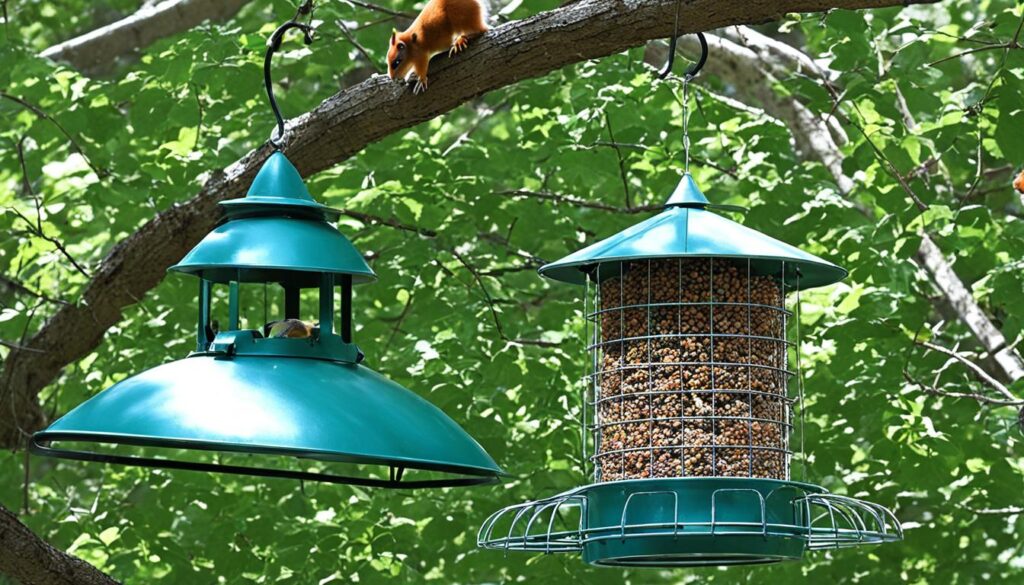
“Squirrels are persistent, but with the right deterrents, you can keep them away from your bird feeders and ensure your feathered friends have a safe and enjoyable dining experience.”
It’s important to note that while squirrel-proof measures can be highly effective, they may not completely eliminate the problem. Persistent squirrels may still attempt to access the feeder, and you may need to try a combination of strategies to find the most successful approach for your particular situation.
Providing Shelter and Safety Around Feeders
Creating safe havens for birds near their feeders is essential to attract and retain them. Birds are naturally cautious creatures, and they need to feel secure in their feeding environment. By providing cover and refuge around the feeder, you can make your backyard a more inviting and comfortable space for your feathered friends.
Consider placing your bird feeder in a natural spot, such as near shrubbery or trees. This gives birds a quick escape route if they feel threatened by potential predators like cats or hawks. Positioning the feeder 10-12 feet away from potential cover allows birds to retreat to safety if needed.
- Choose a quiet location, away from high-traffic areas, to minimize disturbances and make birds feel at ease.
- Ensure the feeder is in a visible place, where birds can easily spot it, but also has nearby shelter they can use for refuge.
- Incorporate a bird bath or bird house near the feeder to create a more complete bird-friendly environment.
By creating safe havens and providing cover around your bird feeders, you can encourage more birds to visit and feel comfortable feeding in your backyard.
“Giving birds a sense of safety and security is key to attracting them to your feeder. They need to know they have a quick escape route and a place to hide if needed.”
Remember, different bird species have varying preferences, so experiment with various feeding stations, food types, and placement options to cater to a diverse range of feathered visitors. With patience and a bird-friendly habitat, you can create a thriving backyard oasis that provides refuge and sustenance for your local avian community.
Considering Seasonal Migration Patterns
As the seasons change, so too do the patterns of bird activity at your feeders. While birds visit feeders year-round, activity levels typically peak during migratory and nesting seasons. Understanding these seasonal changes in bird activity can help you better anticipate and cater to the needs of your feathered visitors.
In the fall, for instance, bird activity may quiet down a bit as natural food sources become more abundant thanks to summer rains. Many migratory birds will begin their southward journey in September, though some species may depart even earlier. As these migrants head out, you may start to spot new species of birds arriving to spend the winter at your feeders.
To accommodate these migratory patterns affecting bird feeders, be sure to offer a variety of popular seeds like black sunflower seeds. This will not only attract your regular visitors but also welcome some new feathered friends as the migration season unfolds.
“Over half of the more than 650 species of North American breeding birds are migratory, with long-distance migrants covering distances ranging from the United States and Canada to Central and South America.”
By understanding and adjusting to the seasonal ebbs and flows of bird activity, you can ensure your feeder remains a welcoming and productive destination for your avian neighbors year-round.
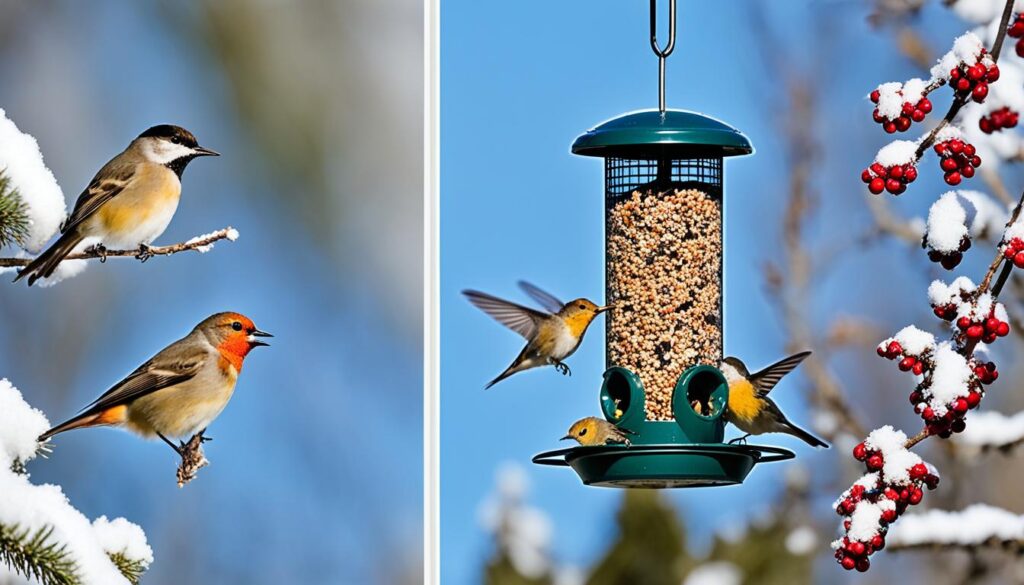
Conclusion
Understanding why birds may not be coming to your feeder and what you can do to remedy these issues can help your outdoor space become a bird-friendly environment. From addressing predators and disturbances to ensuring proper feeder placement, cleanliness, and high-quality seed, there are many steps you can take to make your backyard a welcoming oasis for our feathered friends.
Whether it’s the presence of natural food sources, seasonal migration patterns, or even the emergence of cicadas, the reasons for a decline in bird activity at your feeder can vary. By staying informed and making the necessary adjustments, you can create an inviting habitat that attracts a diverse array of bird species throughout the year.
With a little patience and the right approach, you’ll soon be enjoying the sights and sounds of a thriving bird population at your very own feeder. By maintaining a clean and well-stocked feeder, providing appropriate food options, and ensuring the safety and comfort of your avian visitors, you can make your outdoor space a true haven for birds to enjoy.
FAQ
Why aren’t birds coming to my bird feeder?
There could be a number of reasons why birds aren’t visiting your new feeder, including the presence of predators, lack of fresh or appropriate seed, noise and disturbances, natural food sources and seasonal changes, improper feeder placement and height, unclean feeders, and birds needing time to discover a new feeding source.
What kind of predators can keep birds away from my feeder?
Predators like raccoons, squirrels, chipmunks, larger birds, and even outdoor cats can deter birds from coming to your feeder. It’s important to take measures to deter these predators by placing your feeder high off the ground and away from potential shelter.
How can I make sure my bird seed is fresh and appealing?
Check your bird seed regularly for signs of mold, mildew, or spoilage. Make sure to store the seed properly and refill the feeder with fresh seed every few days. Avoid using cheap seed mixes with filler that birds won’t eat.
How can noise and disturbances impact birds visiting my feeder?
Birds can be easily frightened by loud noises from busy streets, playgrounds, or even boisterous people. Place your feeder in a quiet, secluded part of your yard to minimize disturbances and give the birds a peaceful feeding environment.
Do seasonal changes affect bird activity at my feeder?
Yes, birds may visit your feeder less frequently during warmer months when natural food sources are more abundant. Consider offering alternative food options like a birdbath to attract birds during these seasons.
What is the ideal placement and height for my bird feeder?
Place your feeder at least 5 feet off the ground and 10-12 feet away from potential shelter like trees or shrubs. This will deter predators and give birds a clear escape route if they feel threatened.
How often should I clean and maintain my bird feeder?
Regularly clean and disinfect your bird feeder to prevent the buildup of mold, mildew, and bacteria. This will keep the seed fresh and make your feeder more appealing to birds.
How long does it take for birds to discover a new feeder?
It may take some time for birds to discover a new feeder, especially if they are not accustomed to seeing one in your yard. Be patient and make sure the feeder is placed in a safe, visible location.
What types of bird seed should I use to attract the most visitors?
Offer high-quality seed blends that cater to the specific needs of the birds in your area, such as black oil sunflower seeds. Avoid cheap seed mixes with filler that birds won’t eat.
How can I prevent my feeder from becoming clogged or defective?
Regularly check your feeder for any obstructions or defects that could prevent the seed from flowing freely. Clean out any old, clumped seed and ensure the feeder is functioning properly.
How can I deter unwanted visitors like squirrels from my bird feeder?
Use squirrel-proof feeders with weight-sensitive perches or install baffles to prevent squirrels from accessing the seed. Placement of the feeder is also key to making it less accessible to these pests.
What else can I do to make my backyard more bird-friendly?
Provide nearby shelter and cover, such as trees, shrubs, or birdhouses, to give birds a safe place to retreat. Adding a birdbath can also attract more birds to your yard.
How do seasonal bird migration patterns affect activity at my feeder?
Birds’ feeding habits and migration cycles can impact the activity at your feeder throughout the year. You may see more traffic during spring and fall as migratory birds pass through, and less activity during the warmer months when natural food sources are more abundant.
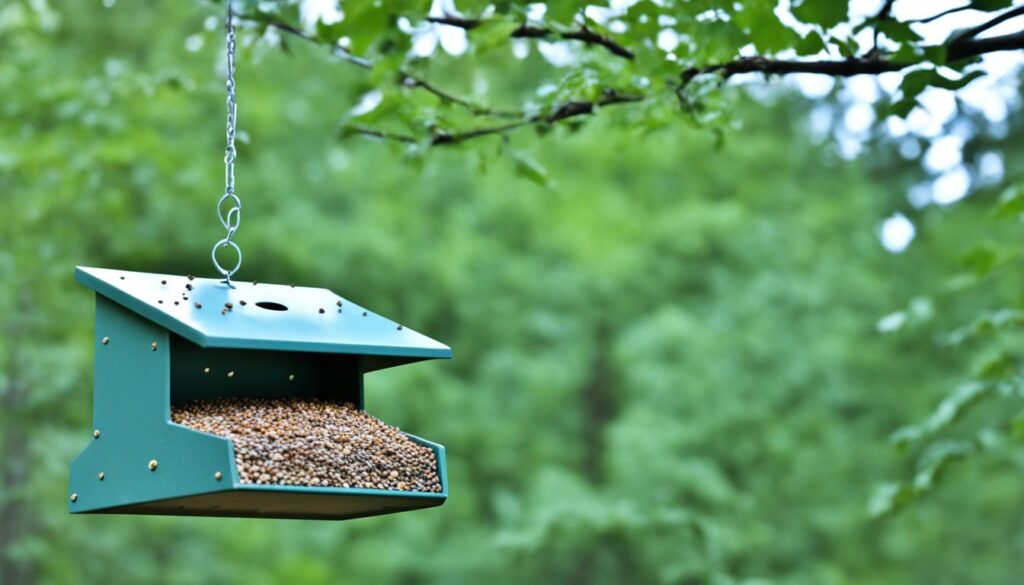

гарантия при продаже аккаунтов https://birzha-akkauntov-online.ru
продажа аккаунтов соцсетей покупка аккаунтов
продать аккаунт https://magazin-akkauntov-online.ru
профиль с подписчиками продать аккаунт
продать аккаунт маркетплейс аккаунтов соцсетей
площадка для продажи аккаунтов https://kupit-akkaunt-top.ru/
продажа аккаунтов биржа аккаунтов
Online Account Store Gaming account marketplace
Account market Accounts marketplace
Sell accounts Account Selling Service
Account Selling Platform Account exchange
Account market Secure Account Sales
Account marketplace Verified Accounts for Sale
Sell Account Account Exchange Service
Website for Buying Accounts Account marketplace
Ready-Made Accounts for Sale Account Trading
Online Account Store https://socialmediaaccountsale.com
account trading platform account marketplace
account acquisition account buying platform
account marketplace account trading platform
account trading profitable account sales
account acquisition guaranteed accounts
buy pre-made account account exchange
sell accounts database of accounts for sale
account buying service gaming account marketplace
social media account marketplace account acquisition
accounts for sale marketplace for ready-made accounts
accounts market database of accounts for sale
account trading platform guaranteed accounts
account buying service website for buying accounts
buy pre-made account account exchange
account sale ready-made accounts for sale
marketplace for ready-made accounts account buying platform
sell account accounts marketplace
sell accounts accounts for sale
account market purchase ready-made accounts
verified accounts for sale accounts market
guaranteed accounts sell accounts
account trading marketplace for ready-made accounts
account catalog verified accounts for sale
secure account sales guaranteed accounts
account buying platform buy pre-made account
account market account market
account selling platform account buying platform
account exchange service account buying service
account catalog https://accounts-offer.org
profitable account sales accounts marketplace
account trading platform https://buy-best-accounts.org
gaming account marketplace https://accounts-marketplace.live
verified accounts for sale account marketplace
account catalog https://buy-accounts.space
buy accounts https://buy-accounts-shop.pro
account purchase https://buy-accounts.live
purchase ready-made accounts https://social-accounts-marketplace.live
buy and sell accounts https://accounts-marketplace.online
площадка для продажи аккаунтов https://akkaunty-na-prodazhu.pro/
купить аккаунт https://rynok-akkauntov.top
продать аккаунт https://kupit-akkaunt.xyz/
покупка аккаунтов https://akkaunt-magazin.online
продать аккаунт https://akkaunty-market.live/
продажа аккаунтов https://kupit-akkaunty-market.xyz
площадка для продажи аккаунтов https://akkaunty-optom.live
продажа аккаунтов https://online-akkaunty-magazin.xyz/
купить аккаунт akkaunty-dlya-prodazhi.pro
площадка для продажи аккаунтов https://kupit-akkaunt.online/
buy fb ad account https://buy-adsaccounts.work
cheap facebook accounts https://buy-ad-accounts.click
buying facebook account buy facebook ad account
facebook ad accounts for sale buying facebook ad account
buy facebook accounts for ads buy facebook ads account
facebook accounts to buy https://buy-ads-account.work
facebook ads accounts https://ad-account-for-sale.top/
Эта публикация завернет вас в вихрь увлекательного контента, сбрасывая стереотипы и открывая двери к новым идеям. Каждый абзац станет для вас открытием, полным ярких примеров и впечатляющих достижений. Подготовьтесь быть вовлеченными и удивленными каждый раз, когда продолжите читать.
Углубиться в тему – https://medalkoblog.ru/
buy facebook accounts for ads https://buy-ad-account.click
buy fb account buy facebook advertising accounts
buy verified google ads accounts google ads account seller
buy google ad threshold account https://buy-ads-accounts.click
buy facebook profiles https://buy-accounts.click
buy google ads https://ads-account-for-sale.top
buy aged google ads account https://ads-account-buy.work
buy google ads accounts https://buy-ads-invoice-account.top
adwords account for sale https://buy-account-ads.work
old google ads account for sale https://buy-ads-agency-account.top